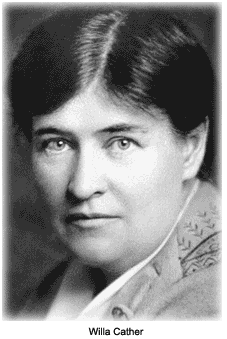 Willa Cather ranks among the most recognized female American authors. She is known for her depictions of prairie life in her novels.
Early days
Willa Cather was born on December 7, 1873, in Back Creek Valley, Virginia. She was the eldest child of four, born to Charles Cather, who was a deputy sheriff, and Mary Virginia Boak Cather.
In 1883, the family moved to join Willa's grandparents in Webster County, Nebraska. The following year, they moved to Red Cloud, where her father opened a loan and insurance office. Willa’s mother was vain, mostly concerned with fashion, and tried to turn Willa into a "lady." Willa defied the norms for the way girls behaved by cutting her hair short, and wearing pants instead of dresses. While they were in Red Cloud, she met Annie Sadilek, whom she used for the character Antonia, in My Antonia.
In 1890, Willa graduated from Red Cloud High School. She then moved to Lincoln, Nebraska, so she could study for the entrance exam at the University of Nebraska. She was accepted, worked on the school magazine, and published articles and play reviews in the local papers. In 1892, Willa published her first short story, “Peter,” in Boston magazine. She graduated from the university in 1895, and returned to Red Cloud until she was offered a position at Home Monthly in Pittsburgh, Pennsylvania.
In 1905, a collection of short stories, Troll Garden, was published. It found the attention of S.S. McClure, who offered Cather a position at his New York publication, McClure's Magazine. She moved to New York in 1906, and became the managing editor.
On her own
In 1912, Cather left the magazine to do her own writing. She published Alexander’s Bridge the same year. In 1913, Cather published O Pioneers, and in 1917, she wrote My Antonia while living in New Hampshire.
In 1923 Cather won the Pulitzer Prize for One of Ours and in the same year A Lady Lost was published. In that novel, she used the memory of Lyra Garber, the beautiful wife of a prominent banker in Red Cloud. During that time, her novels focused on the destruction of provincial life and the death of the pioneering tradition.
The Professor's House was published in 1925. The novel reflects Cather's own sense of alienation within the modern world. In Death Comes for the Archbishop (1927), Willa drew from the life of Archbishop Lamy, the Catholic French missionary to New Mexico in the 1850s. Cather created Bishop Latour, who ministered to the Mexican, Navajo, Hopi, and American people of his diocese. Some consider the book to be her best work.
Busy to the end
Cather maintained an active writing career, publishing novels and short stories for many years, until her death on April 24, 1947. She was buried in New Hampshire.
In 1973, Willa Cather was honored by the United States Postal Service with her image on a postage stamp. She also was inducted into the Nebraska Hall of Fame.
Willa Cather ranks among the most recognized female American authors. She is known for her depictions of prairie life in her novels.
Early days
Willa Cather was born on December 7, 1873, in Back Creek Valley, Virginia. She was the eldest child of four, born to Charles Cather, who was a deputy sheriff, and Mary Virginia Boak Cather.
In 1883, the family moved to join Willa's grandparents in Webster County, Nebraska. The following year, they moved to Red Cloud, where her father opened a loan and insurance office. Willa’s mother was vain, mostly concerned with fashion, and tried to turn Willa into a "lady." Willa defied the norms for the way girls behaved by cutting her hair short, and wearing pants instead of dresses. While they were in Red Cloud, she met Annie Sadilek, whom she used for the character Antonia, in My Antonia.
In 1890, Willa graduated from Red Cloud High School. She then moved to Lincoln, Nebraska, so she could study for the entrance exam at the University of Nebraska. She was accepted, worked on the school magazine, and published articles and play reviews in the local papers. In 1892, Willa published her first short story, “Peter,” in Boston magazine. She graduated from the university in 1895, and returned to Red Cloud until she was offered a position at Home Monthly in Pittsburgh, Pennsylvania.
In 1905, a collection of short stories, Troll Garden, was published. It found the attention of S.S. McClure, who offered Cather a position at his New York publication, McClure's Magazine. She moved to New York in 1906, and became the managing editor.
On her own
In 1912, Cather left the magazine to do her own writing. She published Alexander’s Bridge the same year. In 1913, Cather published O Pioneers, and in 1917, she wrote My Antonia while living in New Hampshire.
In 1923 Cather won the Pulitzer Prize for One of Ours and in the same year A Lady Lost was published. In that novel, she used the memory of Lyra Garber, the beautiful wife of a prominent banker in Red Cloud. During that time, her novels focused on the destruction of provincial life and the death of the pioneering tradition.
The Professor's House was published in 1925. The novel reflects Cather's own sense of alienation within the modern world. In Death Comes for the Archbishop (1927), Willa drew from the life of Archbishop Lamy, the Catholic French missionary to New Mexico in the 1850s. Cather created Bishop Latour, who ministered to the Mexican, Navajo, Hopi, and American people of his diocese. Some consider the book to be her best work.
Busy to the end
Cather maintained an active writing career, publishing novels and short stories for many years, until her death on April 24, 1947. She was buried in New Hampshire.
In 1973, Willa Cather was honored by the United States Postal Service with her image on a postage stamp. She also was inducted into the Nebraska Hall of Fame.